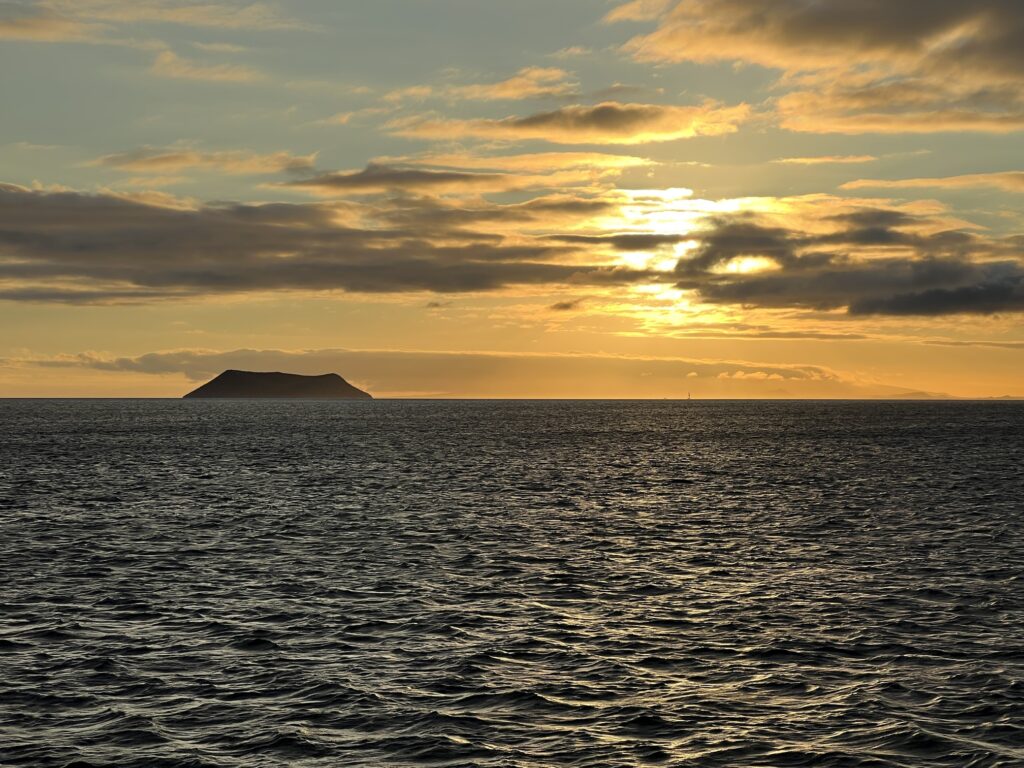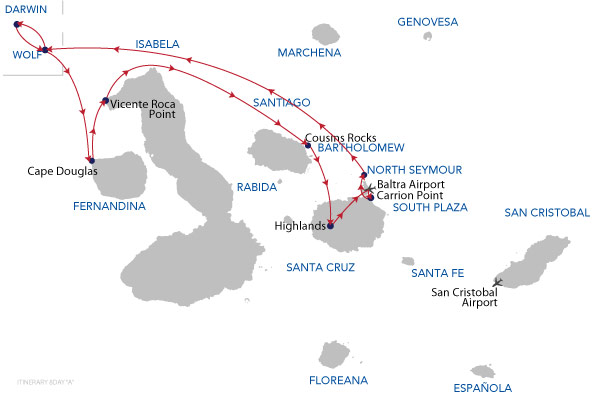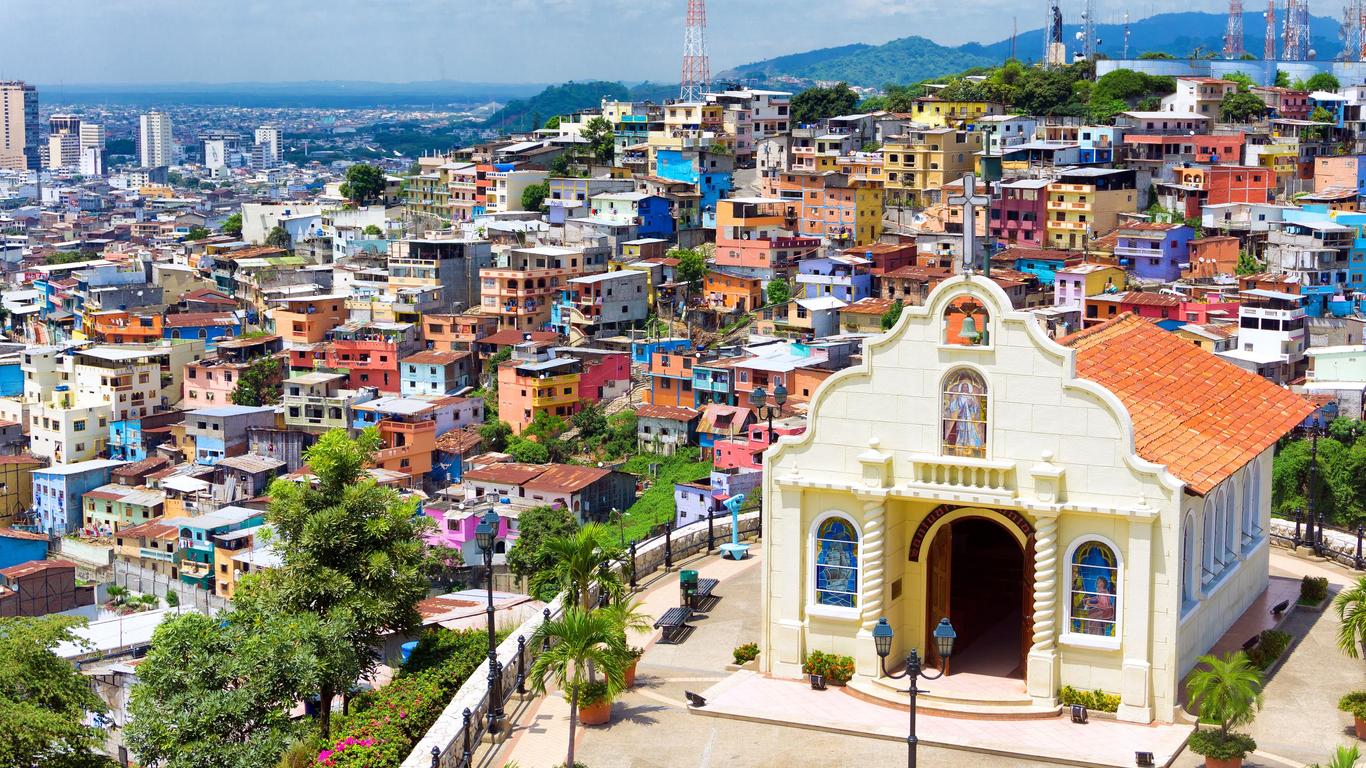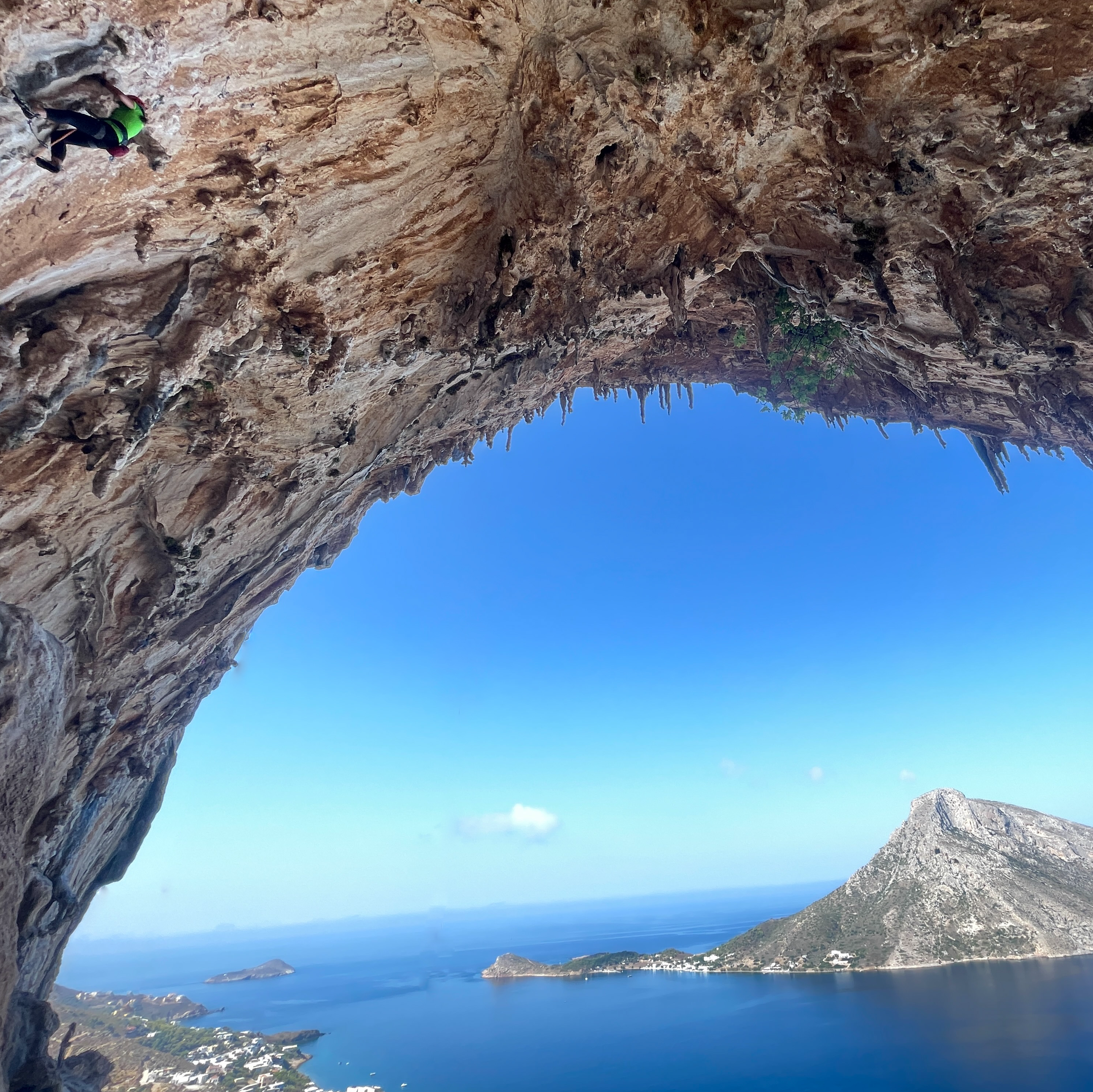Spending a Week on a Liveaboard in the Galapagos
The Galapagos
The Galapagos Islands are a renowned national park and UNESCO World Heritage site. They are 600 miles west of the Ecuadorian coast in the Pacific Ocean. The archipelago consists of 19 islands and dozens of islets over 17,000 square miles, situated right on the equator and spanning both hemispheres. Three major tectonic plates: Nazca, Cocos and Pacific meet here and the ongoing seismic and volcanic activity is what formed these islands. The islands are devoid of vegetation and the lava rocks make the land look more like the moon than your typical tropical destination.
The creatures that call this island their home lack natural predators and have no fear of humans. This makes it easy to see the unique wildlife that inhabits this land. Additionally the confluence of three ocean currents makes the water one of the richest marine ecosystems in the world. The water is incredibly magical and filled with life ranging from sharks to penguins to tropical fish. It was my dream to dive here and trust me, there is a reason these unique islands are on every diver’s bucket list.
TIBURON EXPLORER
I wanted to visit the isolated Wolf and Darwin islands to see the spectacular marine life, but they are only accessible via liveaboard. Therefore, I chose to spend the week on Tiburon Explorer, one of the liveaboard options in the Galapagos. Tiburon Explorer is a 16-passenger boat with 9 bedrooms, all with ocean views. Its beautiful sun deck is a great place to hang out and there is even a jacuzzi on there.
Our week on Tiburon Explorer was 3.5 years in the making. We originally booked in Dec 2018 for a May 2020 trip, but COVID delayed the trip. Since then, Darwin’s arch broke and become Darwin’s towers and the original boat we booked sunk! But we were blessed to be on this new, luxurious boat for a week-long adventure across 8 islands: Baltra, North Seymour, Wolf, Darwin, Fernandina, Isabela, Santiago and Santa Cruz.
Tiburon Explorer Route
Getting from Guayaquil to Baltra
The Ecuadorians take the importance of preserving the Galapagos quite seriously. While it was a domestic flight from Guayaquil, there were a number of checks involved. Prior to checking in, we needed to complete an online form, go to a special desk at the airport to verify the form and pay a fee, and then have our luggage scanned for specific Galapagos restrictions. On arrival, a K-9 checked each and every bag individually before we were allowed to collect our luggage.
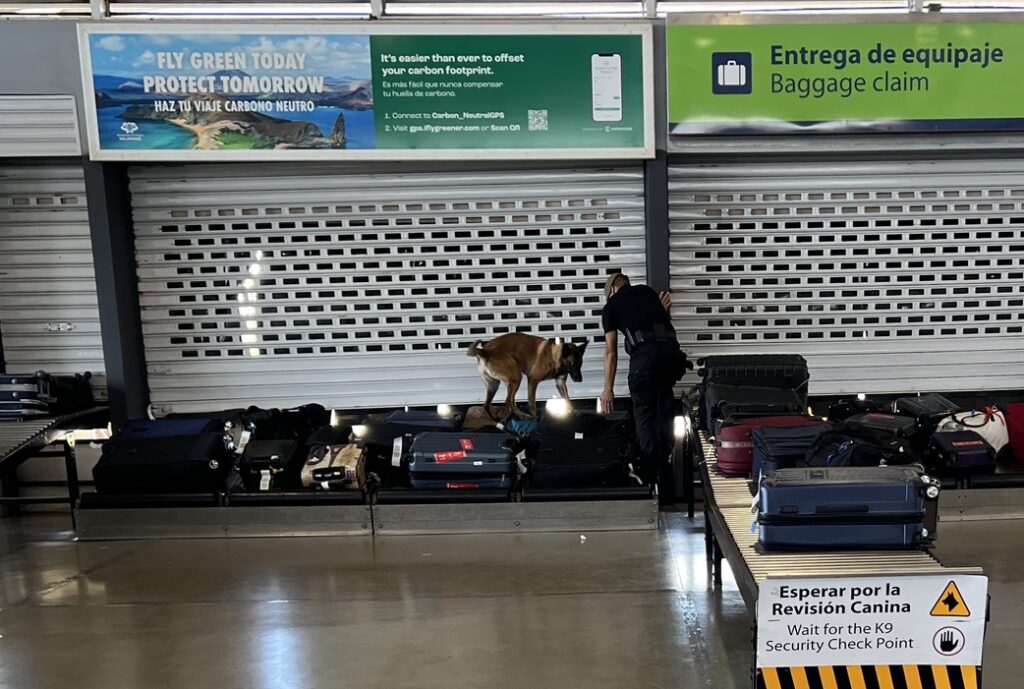
Baltra airport K-9 Check
Arrival in Baltra
Our dive guides, Victor and Natalya, greeted us at the airport. Then we took a short bus ride to the dock and boarded the zodiacs to get to the boat. We setup our gear and the crew took us through a full briefing of the week’s itinerary. Of course, there was also a three course gourmet lunch and dinner, which would be the way all our meals were for the next week.
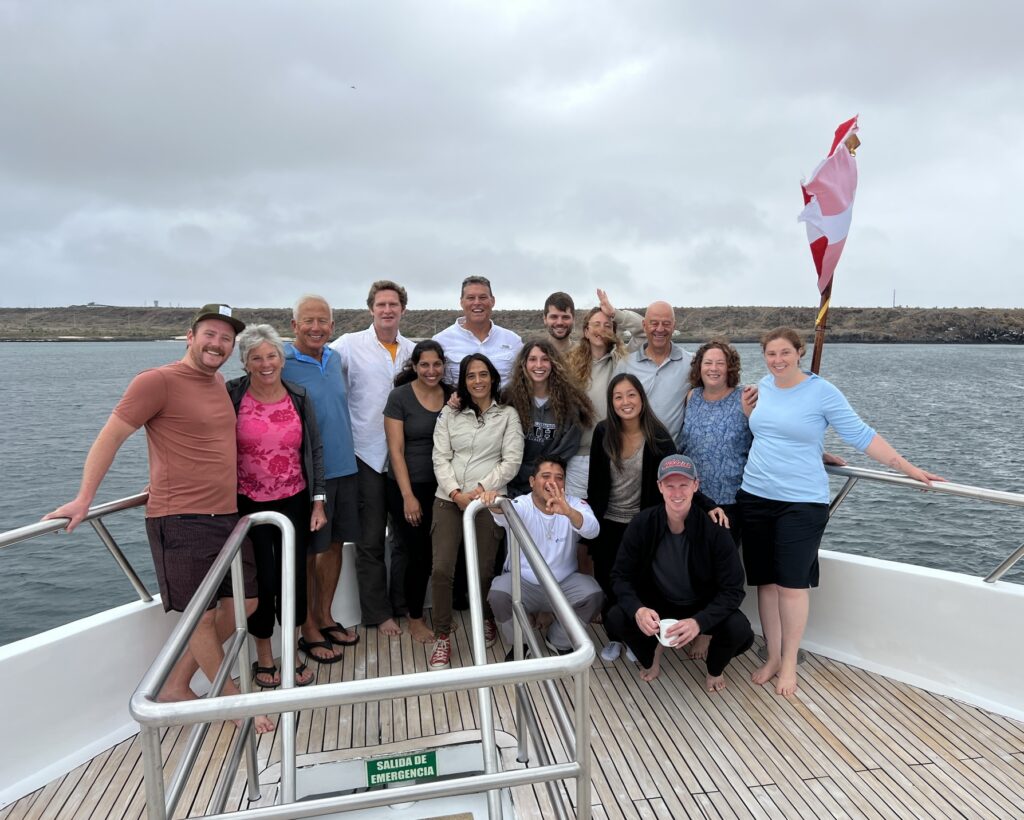
Baltra & Seymour
The real adventure began! Our wake up call was at 6:30 but the engines started running around 5:30 which was a bit of a wake up call in itself. We had a morning briefing and were then broken up into two dive groups, The Sharks and The Iguanas, which would become our dive groups for the week. The process would be the same for each dive: analyse and log air, gear up and jump onto the zodiacs. Fortunately, the crew was at the ready to assist with everything from getting into a 7mm wetsuit to putting on wet gloves, making the process quick and painless.
Our first dive at Seymour was meant to be a low current, easy ‘check out’ dive. The intent was to check our gear and make sure we were weighted correctly, but the current was surprisingly strong. Despite the difficultly, we saw quite a lot: Galapagos eels, turtles, white tip reef sharks, hammerheads, moray eels, eagle rays and more!
The second dive would be our first attempt at ‘negative entry’. In order to avoid drifting too quickly, we emptied out all the air in our BCs, swam down to the bottom and held on to the rocks. It was good practice for the days ahead where we would encounter very strong currents.
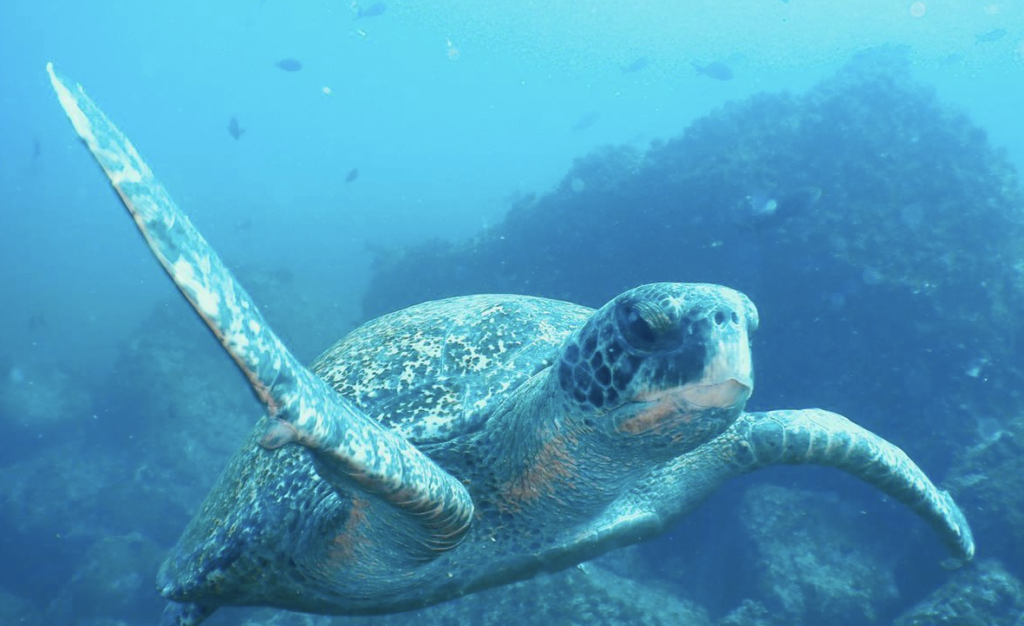
After lunch, we visited the north side of Seymour Island, home to the blue-footed boobies and frigate birds. The blue-footed booby is a marine bird that is native to the tropical regions of the Pacific Ocean. They are easy to spot because of their distinctive bright blue feet, a result of their diet. As part of their mating ritual, males lift their feet up and down strutting before the female. The view is that the brighter the feet, the healthier the male.
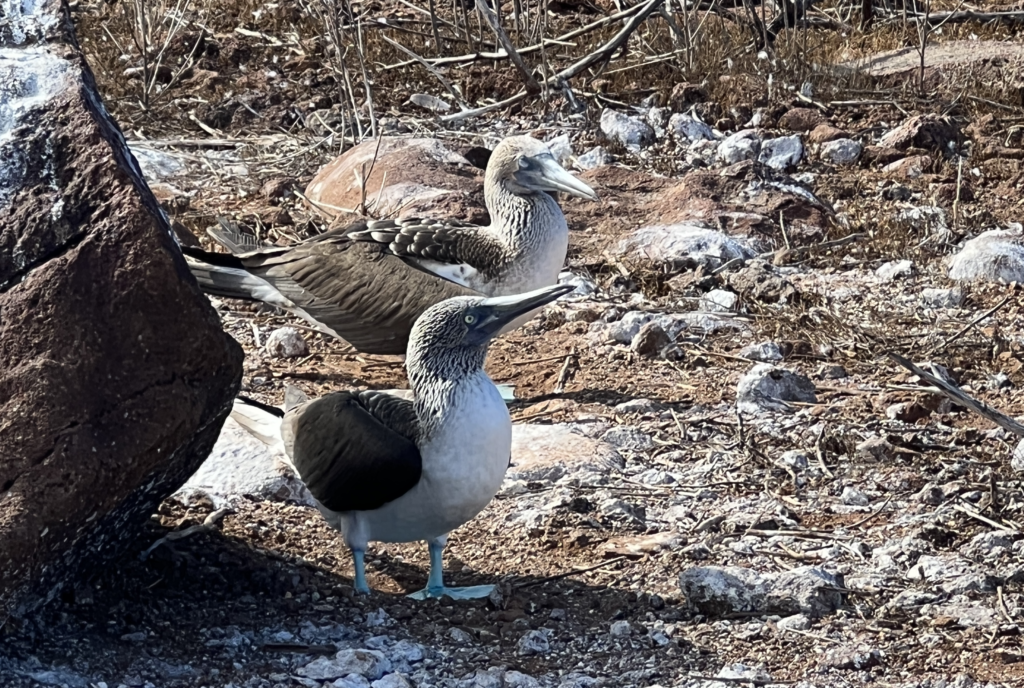
Blue-footed Boobies
The frigate birds are often seen near blue-footed boobies. Because their feathers are not waterproof, they are known for chasing birds, catching leftovers and pushing birds to vomit to feed themselves. They are famous for their courtship ritual in which the males build a nest and inflate their red chest globes like a balloon in order to attract females.
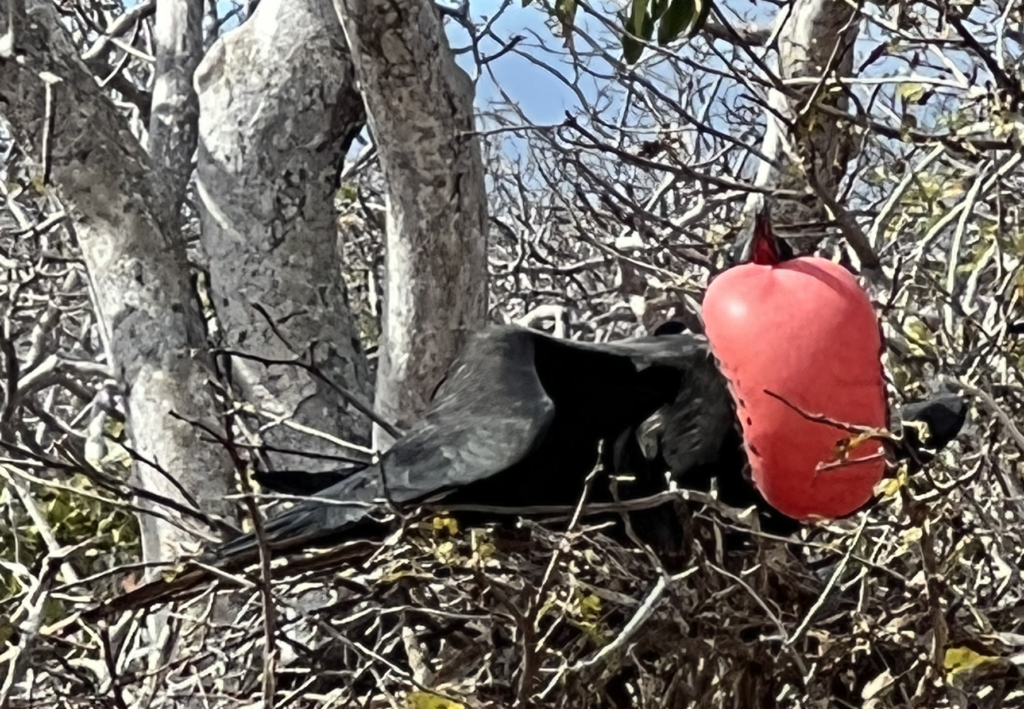
Frigate Birds
We ended our visit by watching the sea lions bask on the rocks and then boarded the zodiacs to return to the boat for dinner and to set sail for the night.
Wolf Island
After a 12 hour crossing, we woke up at Wolf Island. I went out to the dive deck to analyse my air and was greeted by pods of dolphins surrounding the boat!
Our plan for the day was to dive four times, but little did we know what the tricky conditions would bring us. The chop on the surface made it difficult to get onto the zodiacs. Our new skill of negative entry would be paramount to getting to the right starting point at the dive site. The two morning dives had strong currents as we anticipated but these currents also brought an abundance of marine life.
After lunch, we were headed back to the second dive site, Landslide, for another visit with the marine life. Little did we know how quickly currents would change. Not only was the surface choppier, but the currents were significantly stronger.
In my case, I ended up fighting the current and running low on air. On our safety stop, we drifted from the group and surfaced on our own but our SMB was deployed, making it possible for the zodiac driver to spot us. The other group however, got pulled by the current and drifted for several miles. Fortunately, they used their Nautilus GPS devices to send a signal back to the boat and we were able to locate them after 45 minutes at sea.
Given the treacherous conditions, we skipped the fourth dive and set sail to Darwin. We arrived at Darwin near sunset and were greeted by another school of dolphins while approaching the Darwin towers!
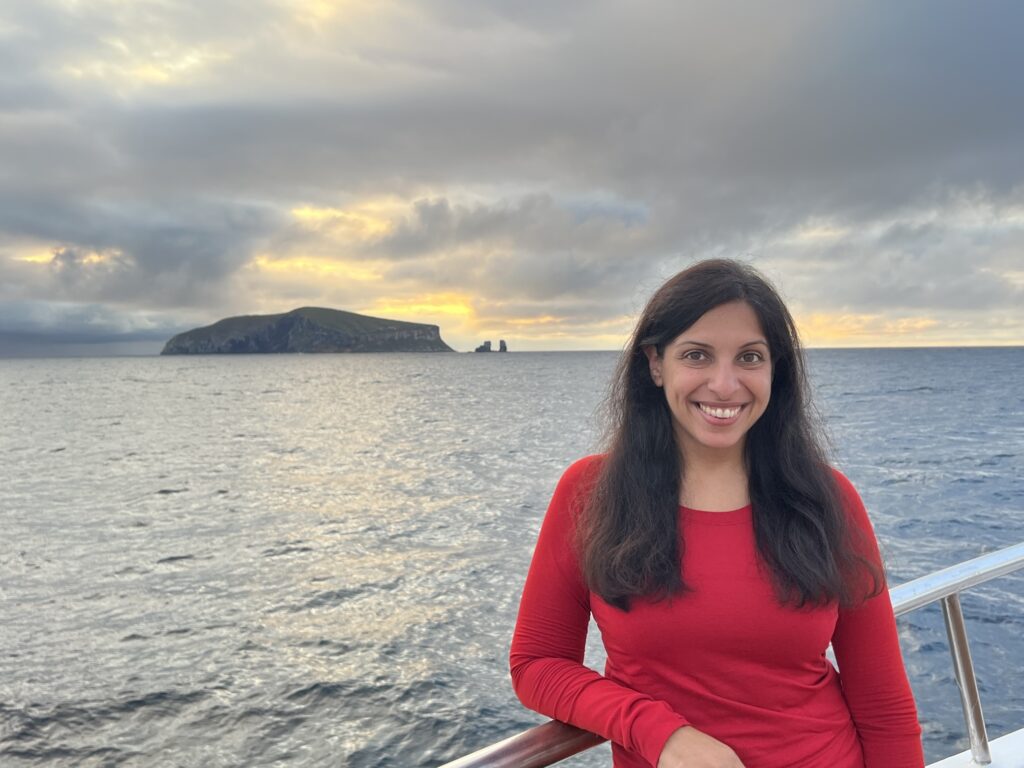
Approaching Darwin’s Towers
Darwin Island
Strong currents continued at Darwin. Only now, we were more confident with negative entry and experienced with gripping the rocks and drifting into low visibility blue waters for our safety stops. We had four great dives filled with quite a bit of marine life: hammerheads, rays, turtles, Galapagos sharks and a ton of fish. We were also fortunate as the dolphins appeared several times on the surface.
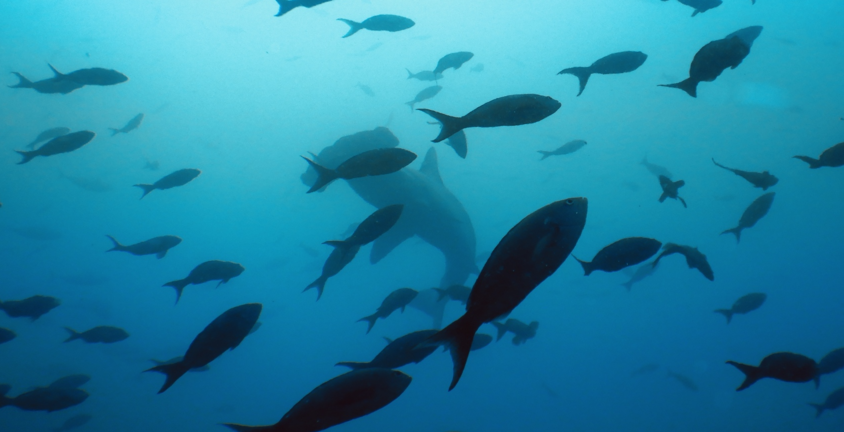
Hammerhead Shark
Wolf Again
We were nervous to come back to Wolf, but it surprised us. The sun was shining and the two morning dives were both relatively calm and the third dive of the day was a milestone dive: my 100th! The group all joined in with great energy — I wore a tutu and two of the other divers put on their special whale shark outfits. We didn’t end up seeing a whale shark, but the dive was fabulous. A pod of golden rays circled round us, several hammerhead sharks and turtles made an appearance and there were plenty of fish.
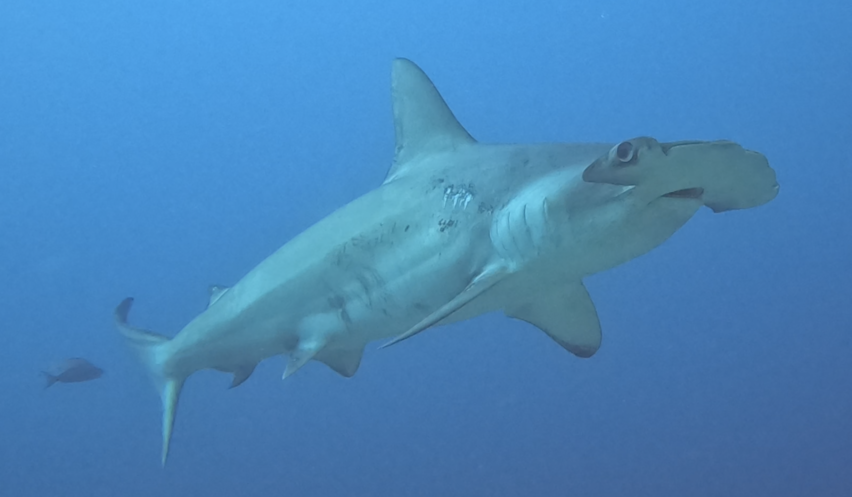
Hammerhead Shark
For our fourth dive, we visited “The Secret Cave”. The cave is a series of marine caverns created by wave erosion. We entered the cave to find countless mobula rays and turtles. They were so close that we literally had to get out of their way.
Following dinner on the sundeck, we set sail for the evening and made our way to Cape Douglas.
Fernandina and Isabela
After three intense days at Wolf and Darwin, we had a leisurely start to the day. Following our 7:30 breakfast, we waited three hours for the marine iguanas to get into the water before making our first dive at Cabo Douglas. The marine iguanas are endemic to the Galapagos and quite special. They are typically found warming themselves in the sun but they enter the water and use their sharp claws to hold onto the rocks and graze on marine algae. They are also known to have very efficient salt glands where they can “sneeze” out the salt, which is also seen from the white colouring on their heads.
The first dive was a shallow dive around 5 meters but it was cold! It didn’t matter as there were tons of marine iguanas eating in the water, sea lions splashing around and even the Galapagos bull shark made an appearance. There was so much entertainment that it was hard to remember how cold it was.
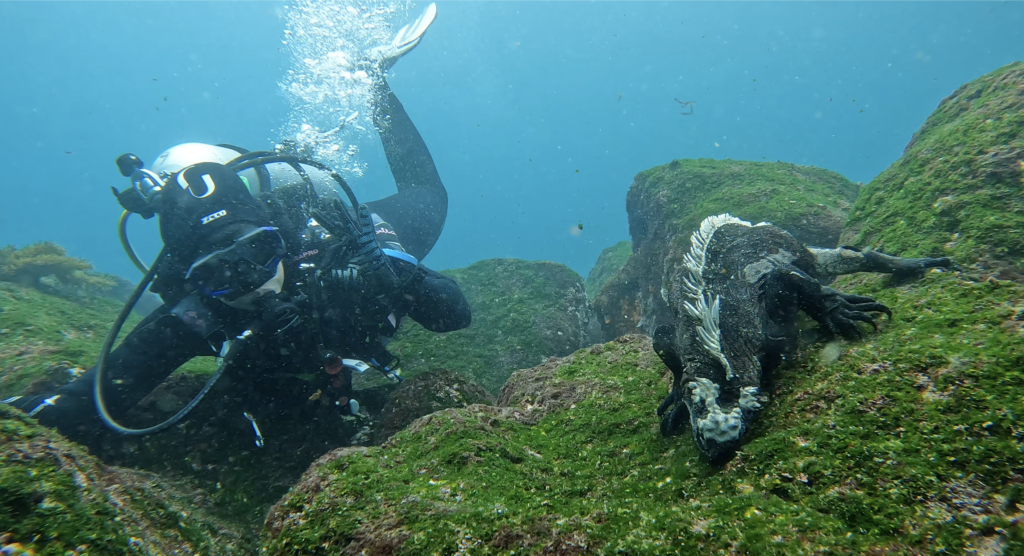
Marine Iguana and me
Once we set sail towards Isabela, we encountered a pod of blue whales swimming around the boat! This was so rare that even the captain came out to take photos of them. Blue whales are the largest mammals on the planet, growing up to 30 meters and weighing 150-200 tons. They are extremely graceful in the water but also capable of swimming up to 25 miles per hour. They are spotted in the Galapagos usually between July and September so it was early for this sighting.
After lunch we arrived at Punta Vicente Roca, our dive site for the next two dives. While I thought the marine iguanas would be a tough act to follow, this dive site delivered. The dive was colder and deeper than the first, but we spotted two mola mola (sunfish) and a manta ray! The dive also had a bunch of macro life and while we were on our safety stop, three sea lions played with us.
The next dive was a cold, deep treasure hunt along the sandy bottom to search for the red-lipped batfish. This bizarre creature is endemic to the Galapagos and looks like it is wearing lipstick. Although it is capable of swimming, the batfish’s fins are better adapted to work as pseudo-legs, helping it to waddle along the sand.
After we surfaced, the zodiac made a detour to the rocks where we saw the Galapagos penguins, the Galapagos cormorant, a pile of sleeping marine iguanas and some sea lions. The Galapagos penguin is endemic to the Galapagos and is the only penguin found north of the equator. It is the second smallest penguin in the world being no more than 20 inches in height. The Galapagos cormorant, with its short scraggly wings, is the only one of 40 cormorant species that cannot fly. It’s the largest of the cormorants and a strong swimmer that darts into the ocean to scavenge for fish. Scientists believe that the loss of flight may have helped this bird survive because it enhances their ability to swim.
It was a very cold diving day but it was so diverse and completely different to the northern islands of Wolf and Darwin.
Santiago Island and Santa Cruz
We sailed from Isabela to Santiago all night but given the strong currents, we had not arrived when we woke up. We had a full schedule with two final dives at Cousin’s Rock followed by an excursion to visit the giant tortoises on Santa Cruz. The last sets of dives were once again filled with marine life, including an octopus!
Following the diving, we disassembled our gear, had lunch and set sail for Santa Cruz. Our final excursion was to the Highlands to visit the giant tortoises at Rancho Manzanilla.
Carlos Guerrero, owner of Rancho Manzanilla setup the property as a tortoise reserve, but the tortoises are not captive and are able to roam freely. These tortoises are the largest living tortoises in the world and can live more than 100 years. We borrowed some wellington boots and toured the property to see the tortoises in their natural habitat.
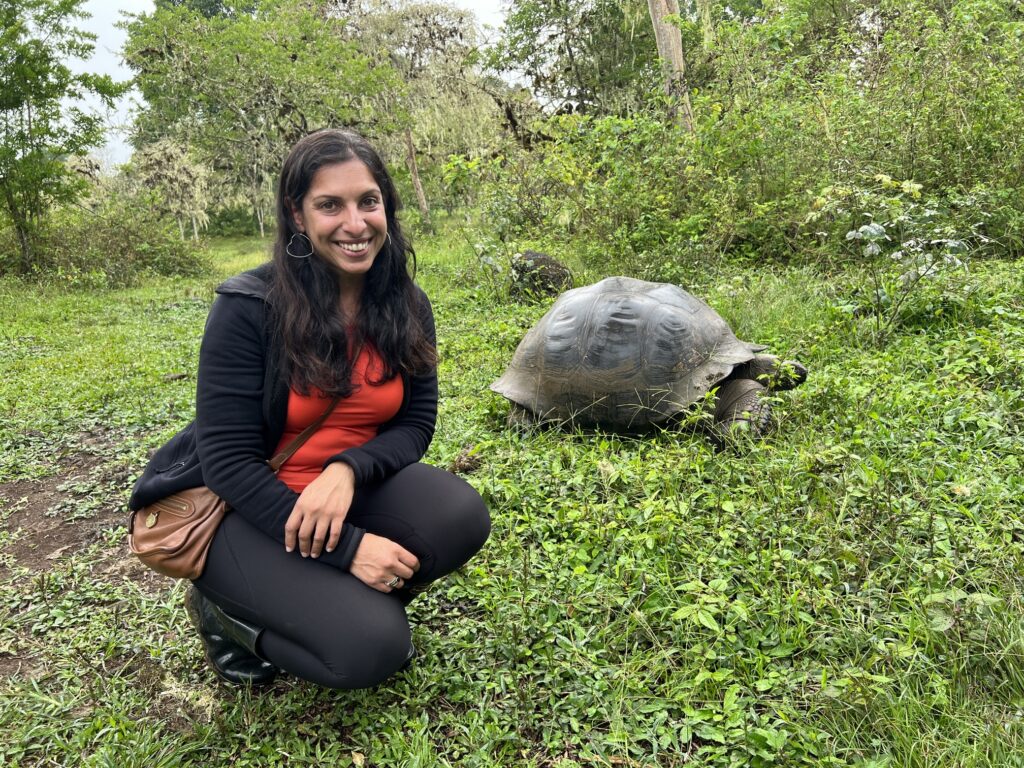
Giant Tortoise
We continued our journey to Puerto Ayora for an evening stroll through town. Around sunset, we visited the baby sharks swimming at the port and then met the group at El Muelle de Darwin for our final dinner. We ended the evening with a zodiac trip back to the boat which was filled with millions of stars glowing over bioluminescent water.
